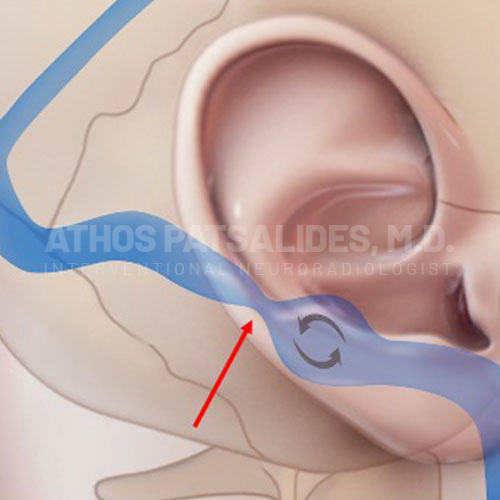Venous Sinuses (or Dural Venous Sinuses) are the large veins of the brain. Their function is to facilitate blood flow from the brain to the neck and the heart. The venous sinuses are divided in the transverse and sigmoid sinuses and they are located on the surface of the brain. Most patients have right and left transverse and right and left sigmoid sinuses, but in the majority of patients one side is larger than the other, sometimes much larger.
What Causes Venous Sinus Stenosis?
Venous sinus stenosis means that the large veins of the brain are narrowed. From my experience with hundreds of patients, one of the most common cause of venous sinus stenosis is enlargement of arachnoid granulations. The arachnoid granulations are valves that normally occur in the wall of the venous sinuses and facilitate from of CSF from the brain to the bloodstream. These can enlarge and protrude inside the venous sinuses causing narrowing. The reason of enlargement of the arachnoid granulations remains elusive.
What can happen beacause of Venous Sinus Stenosis?
Venous Sinus Stenosis is associated with two main conditions, Pulsatile Tinnitus and Idiopathic Intracranial Hypertension.
Pulsatile Tinnitus
Venous Sinus Stenosis can lead to pulsatile tinnitus. The transverse and sigmoid venous sinuses are located in proximity to the ear (from the brain side). Under normal circumstances blood flow is smooth. But if there is significant narrowing, blood flow becomes irregular and turbulent. As a result of this turbulent flow, a “whooshing” or heartbeat sound is produced in the vein and picked up by the ear, causing pulsatile tinnitus. Think of a garden hose; when pinched the water jets. Something similar happens in the venous sinuses; blood “jets” because of the stenosis and the “jet” causes pulsatile tinnitus.
Even though Pulsatile Tinnitus can be an isolated symptom of venous sinus stenosis, it can also occur as part of IIH (see below).
Placement of a stent across the stenosis via a procedure called Venous Sinus Stenting can lead to resolution of the stenosis and the turbulent flow and resolution of the pulsatile tinnitus.
The illustration shows NORMAL venous sinuses in proximity to the ear. Normal blood flow is from the head towards the neck (white arrows).

The illustration shows NARROWED venous sinuses (red arrow) in proximity to the ear. Because of the stenosis there is turbulent blood flow causing pulsatile tinnitus (curved arrows).

Stenting alleviates the stenosis, restores normal blood flow and eliminates pulsatile tinnitus.

Idiopathic Intracranial Hypertension (IIH)
Idiopathic Intracranial Hypertension is a condition of high pressure in the head, manifesting with headaches, vision changes and often pulsatile tinnitus. Even though the cause of increased intracranial pressure is often elusive, high quality evidence from the last 10 years has identified venous sinus stenosis as a potential cause or related factor with IIH.
Cerebrospinal fluid (CSF) is a fluid that circulates though the brain and spinal cord. It is constantly produced and remove from the brain. A major mechanism of CSF removal from the brain is via flow into the venous sinus sinuses. In patients with venous sinus stenosis, blood flow from the brain to the neck is decreased. As a result of the decreased venous flow and built up of pressure in the veins, the CSF cannot be effectively removed. Thus, the CSF is not properly removed from the brain. As CSF is constantly produced, impaired removal of CSF leads to excessive CSF in the brain and increased intracranial pressure and IIH.
In selected patients, a minimally invasive procedure called Venous Sinus Stenting is effective in decreasing intracranial pressure and alleviating symptoms of IIH .
-
The illustration shows normal veins draining blood from the brain towards the neck (blue arrows)

-
The illustration shows venous sinus stenosis (red circles). As a result of the narrowed veins, blood flow from the brain to the neck is compromised, leading to build of pressure in the veins (blue arrows) and subsequently increased intracranial pressure and IIH.

-
The venous sinus narrowing has been treated with placement of a stent (circle). After stenting, the blood flow from the brain to the neck is restored (blue arrows), leading to normalized intracranial pressure and improvement of the symptoms of IIH.

